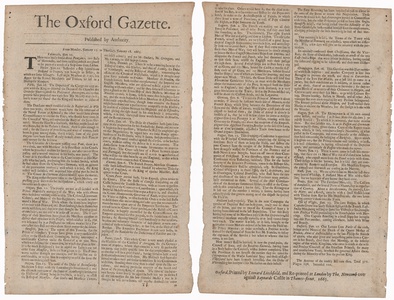| Method | Letterpress |
| Artist | Leonard Lichfield |
| Published | Published by Authority. Oxford, Printed by Leonard Liechfield, and Re-printed at London by Tho. Newcomb over against Baynards Castle in Thames Street, 1665. [1666 NS] |
| Dimensions | Sheet 280 x 182 mm |
| Notes |
The nineteenth edition of the Oxford Gazette, a very rare piece of Oxford ephemera. The current example covers events from Monday January 15th to Thursday January 18th 1666, though the actual printed date given is 1665, as at the time of publication the start of the civil year in England was celebrated on the 25th of March, rather than the 1st of January. The double sided sheet of two columned text contains reports of shipwrecks around Penzance, conflicts between the French crown and the clergy, Dutch naval and military movements, an impromptu duel between the Chevalier de Clermont and Monsieur de la Fevillade, attempts at peace talks between Spain and Portugal, positions of the French fleet in the Channel and the Mediterranean, the sighting of Dutch Men-of-War off the coast near Whitby, the arrival of various cargo ships to English ports carrying timber, herring, wine, and brandy, and letter from Paris containing news of the death of Anne of Austria, Queen mother of the King of France, from a long fight against breast cancer. Perhaps the most interesting, though gruesome, detail is the weekly Bill of Mortality, appended to the end of the reports, providing details of deaths from Plague and the increase in cases from the previous week. 158 deaths were attributed to plague in the four days of the current issue, though the number was likely to have been much higher. Before the Great Plague, there had been no formal system for the recording of deaths, with parishes instead appointing 'searchers of the dead' to carry out a tally and record causes of death. These searchers were rarely medically trained, and thus, commonly misreported cause of death. Contemporary accounts also attribute some inconsistencies to deliberate misreporting, most likely through bribery to avoid the consequences to family members of plague victims. Under quarantine rules, the close contacts of plague sufferers were confined to their homes under armed guard for 40 days, which was often a death sentence to the entire household either through plague or neglect. The Oxford Gazette was established in November 1665, to provide an official record of news of the day while the Court of King Charles II was in Oxford during the Great Plague of London. One of the world's oldest newspapers, the Oxford Gazette was retitled the London Gazette for its 24th issue, once the King and Parliament had returned to the City. By the summer of 1665, the plague was rife in the densely populated and unsanitary streets of the City and its adjoining slums, prompting the King, along with most of the wealthier elements of London, to quit the City in favour of parts of the country as yet unaffecting by plague. Retiring originally to Salisbury, Charles and his cabinet set up in Oxford following another outbreak in Salisbury. The gazette, under the auspices of one of the King's favourites, Henry Bennett, Earl of Arlington, was first published on the 7th of November, to provide an official substitute to the various London newspapers whose production had been suspended by the plague. The university printer at the time was the younger Leonard Litchfield, son of the printer of the same name who had published the official declarations of Charles I when he had been resident in Oxford during the Civil War. Leonard Litchfield II (d.1685) was an Oxford-based printer and publisher, and the third in a line of publishers who served as printer to the University of Oxford. His grandfather John was University printer between 1617 and 1635, and was succeeded upon his death by his son Leonard Litchfield I (1604-1657), who was printer to the King during Charles I's residency in Oxford during the Civil War. For his involvement with the Royalist cause, his house and studio were burned by the Parliamentarians. Following the Restoration, his son, Leonard II was elevated once again to the position of printer for the University, as well as serving as yeoman bedell. He was in turn succeeded by his own son, Leonard III (fl.1710s). Condition: Binders holes, creases, and chips to left edge of sheet, not affecting text. Minor time toning to edges of sheet. Otherwise a clean and neat example. |
| Framing | unmounted |
| Price | £1,500.00 |
| Stock ID | 52609 |

